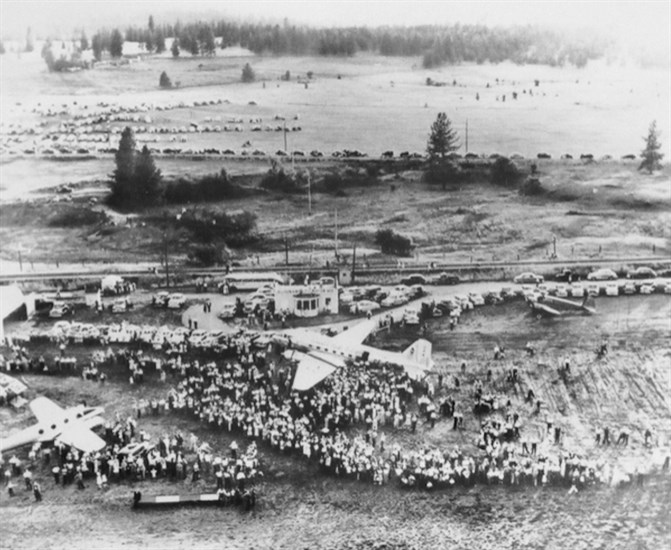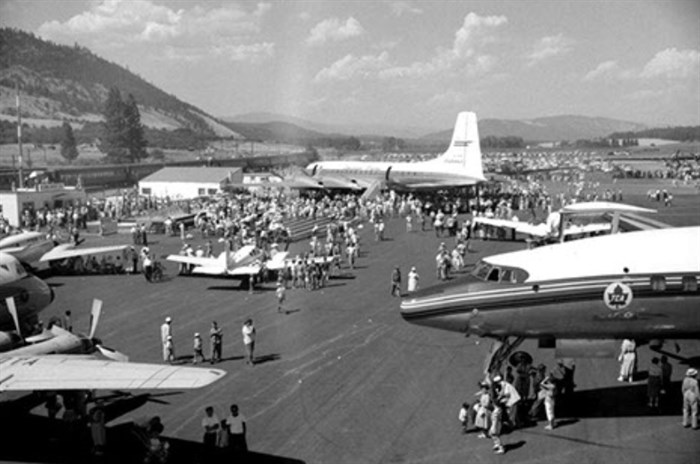
Kelowna International Airport turns 75 this year. This photo is from the 1949 official opening of the airport terminal building.
Image Credit: Submitted/City of Kelowna
April 19, 2022 - 7:00 AM
When people look back on what moved Kelowna from the “ugly sister” of the Okanagan’s three largest cities to the booming city it has become today, they point to a number of factors.
First, and most visible, is the Floating Bridge. It opened across Okanagan Lake in 1958 that connected the city to the Lower Mainland in a way the ferry boats never did. The opening of UBC Okanagan in 2005 ad the expansion of Kelowna General Hospital into a major regional facility were all factors.
Perhaps the biggest trigger to Kelowna’s growth was the arrival of a Curtiss biplane in a wooden crate in 1913 that led, in time, to a narrowly approved plebiscite to buy land for what is now Kelowna International Airport.
“The way the aviation industry works is, if you build a mile of road, you get a mile of road,” Sam Samaddar, the airport director since 2008, told iNFOnews.ca. “If you build a mile of rail, you get a mile of rail. If you build a mile of runway, you get the world. That’s why airports are such important economic assets in their community. A community that doesn’t have an airport of some significance, they’re just stifled in terms of their growth.”
Kelowna International Airport celebrates its 75th anniversary this year but its creation goes back some years before that and is a testament to the foresight of political and business leaders, Samaddar said.
In 1913, the Curtiss biplane arrived in crates. It was assembled and, using bamboo floats, took off and circled Kelowna Regatta.
It led many into a love affair with flying and the creation of the Boyce Field near what is now Boyce Gyro Beach in the 1920s.
Later, in 1927, Rutland Airfield was built, east of the Highway 97 and Highway 33 intersection. While it remained in use until 1945, it did not have the room to expand that visionaries of the day wanted.
“If you really look at the history of the airport, the work started in the late 1930s,” Samaddar said. “The political leadership, the business leadership of the day said 'look, if Kelowna wants to be a community (to be reckoned with), it needs its own airport and needs an airport that can grow.'”
It was seen as a way to support the development of the burgeoning fruit and vegetable industries of the day.
Studies were done on things like a suitable location, influence of weather and distance from other Interior cities from which users could be drawn. It was pointed out that, not only did the railway and highway pass close to what was then a tobacco field in far off Ellison, but so did gas and electrical lines.
The goal, from the start, was to meet the aviation standards of the day so it could be certified but also to have room to grow.
During the Second World War, Penticton had the major airport in the region and it was used for training Commonwealth pilots.
Kelowna, as historian Bob Hayes is prone to say, was a backwater, the ugly sister of the three cities in the Valley. Penticton had the airport while Vernon had better shopping, Hayes said. Kelowna was just someplace to get through on the journey from one city to the other.
Samaddar doesn’t know why it took so long, but a plebiscite for the $20,000 cost of buying the Dickson Ranch in Ellison went to the public in 1946.
It passed by a mere six votes: 466 to 460.
It took until late 1947 for the first official flight to take off from the 3,000-foot grass Ellison Field airstrip. The official opening was in 1948, after it got certification, and a small terminal building was put up at the north end of the strip, near what is now the Carson Air building, with its official grand opening in 1949.
The first commercial Canadian Pacific Airline flight to Vancouver didn’t take off until 1958.

This is the official opening of the newly expanded airport in 1960.
Image Credit: Submitted/Kelowna Flying Club
That was two years after the grass airstrip was converted to gravel. Two years later, the runway was extended to 5,360 feet and paved, at a cost of $312,000.
The runway was extended to 7,300 feet in 1990 at a cost of $3.6 million and grew, again, to 8,900 feet in 2008. It will be extended slightly more this year for safety reasons but, given the technology of new aircraft, it may not need to grow any longer in the future, Samaddar said.
Over those years, Kelowna airport has grown well beyond what cities like Penticton and Kamloops could boast to become the 10th busiest airport in the country.
“Over time, there’s been these key decisions,” Samaddar said. “The decision to buy land and in a special place to build an airport. The investment in things like the runway and runway extensions over time that have set the Kelowna airport apart from those other airports. It has been able to serve its community very well.”
That’s what Samaddar meant by building a runway and bringing the world.
If not for the 1990 extension, WestJet would not have come to Kelowna in 1996. Had the 2008 extension not happened the largest airplane to ever land at the airport, the Antonov transport plane from Kazakhstan, would not have been able to land in 1998.
It’s still the largest aircraft to have landed in the city.
The longer runway lengths also allowed for direct flights to places like Cuba and Hawaii.

This is undated photo shows a Canadian Pacific plane. Commercial flights didn't start until 1958.
Image Credit: Submitted/City of Kelowna
The runway extensions were also key to the growth of Kelowna Flightcraft, what is now KF Aerospace. It is Kelowna’s largest private employer.
“Every airport in the world would love to have a Barry Lapointe, KF Aerospace on their airfield,” Samaddar said. “These are highly sought after businesses and here we have aircraft from around the world coming here to get maintained. The quality of jobs that are created, clean jobs, are just tremendous for our community.”
The airport is also a big reason why Kelowna has become such a draw for people from other parts of Canada.
“If you look at why people make decisions to come and live here – they may have businesses elsewhere – but the reason they come to live here is because the amenities, such as an airport where they can get in and out fairly quickly and get to where they need to go," Samaddar said.
READ MORE: iN PHOTOS: Round the world Spitfire flight arrives in Kelowna to hundreds of fans
There are no records on passenger counts from the days of the old terminal building.
Samaddar estimates that 300,000 people a year flew in and out of Kelowna Airport from 1992 to1996.
Passenger counts are available from 1996 on. That year, 582,042 people flew in and out of the airport. That jumped by 27% to 741,547 in 1997, the largest year-over-year increase over the last 25 years, when WestJet came and Air Canada expanded its flight options.
There was slow and steady growth every year until 2005. The one exception was a 1% drop in 2002.
In 2005, there was a 21% jump that took the airport past the one million mark for the first time, hitting 1,078,652 passengers.
After that, there were good and bad growth years. Two years were down a couple of per cent, most were up a bit, but the counts stayed above one million each year until the two million mark was passed in 2018.
Things were going so good – Kelowna International Airport was the 10th busiest in the country – that a plan called Soaring Beyond 2.5 Million was created. It called for construction to start immediately on a number of upgrades to the terminal building, parking and “airside” facilities.
In December 2019, the city approved almost $70 million in spending – mostly coming from reserve funds and airport users fees since the airport is fully self-funded.
READ MORE: Kelowna Airport’s expansion plans on hold due to pandemic
Only a few months later COVID hit. Expansion plans screeched almost to a halt, as did flights. Passenger counts plummeted 64%. Still, in the middle of COVID, 737,447 people flew in and out of Kelowna airport in 2020.
This year, Samaddar is forecasting a 1.7 million passenger count as Kelowna recovers faster than most airports in the country.
READ MORE: UPDATE: Kelowna airport to become international again
It’s still ranked as the tenth busiest although, at times during the pandemic, it ranked sixth or seventh, he said.
The expectation of hitting 2.5 million passengers a year by 2025 is likely going to be pushed off a couple of years into the future.
“Enabling work” is happening this year in preparation for resuming the terminal expansion plans, although inflation and its impact on construction costs are being closely watched.
Over the last 30 years, since 1992, 31.5 million people have flown in and out of Kelowna International Airport.
It’s expected that, by 2045, another 50 to 60 million more will have transited through the airport, with the annual passenger count forecast to hit 3.5 million that year.
It may have been started by a flew flight enthusiasts on a little grass airstrip, but it took leadership and foresight over the generations to create and airport that outshines many larger cities in the country, Samaddar said.
“The growth in the entire region would not have happened had this airport had not been in place and those strategic investments had not been made, and continue to be made,” he said. “The airport is really an economic enabler for the entire region.”
There will be 75th anniversary events later this year, including the opening of the KF Aerospace Centre for Excellence and the Snowbirds air show on July 9 and 10.
READ MORE: Kelowna's KF Aerospace Centre For Excellence a go despite struggling airline industry
KELOWNA INTERNATIONAL AIRPORT TIME LINE:
-
1913 – First airplane to fly in Kelowna
-
1920s – Boyce Field created
-
1927 – Creation of Rutland Afield
-
1946 – Plebiscite to buy Dickson Ranch passed
-
1947 – First official flight
-
1948 – Official opening of the field
-
1948 – Official grand opening with new terminal building
-
1956 – Grass strip converted to gravel
-
1958 – First commercial flight
-
1960 – Runway extended to 5,360 feet
-
1990 – Runway extended to 7,300 feet
-
1996 – WestJet starts operating out of Kelowna
-
1998 – Antonov transport plane lands in Kelowna
-
2005 – Airport surpasses one million passengers for the first time
-
2008 – Runway extended to 8,900 feet
-
2018 – Passenger counts surpass the two million mark
To contact a reporter for this story, email Rob Munro or call 250-808-0143 or email the editor. You can also submit photos, videos or news tips to the newsroom and be entered to win a monthly prize draw.
We welcome your comments and opinions on our stories but play nice. We won't censor or delete comments unless they contain off-topic statements or links, unnecessary vulgarity, false facts, spam or obviously fake profiles. If you have any concerns about what you see in comments, email the editor in the link above.
News from © iNFOnews, 2022